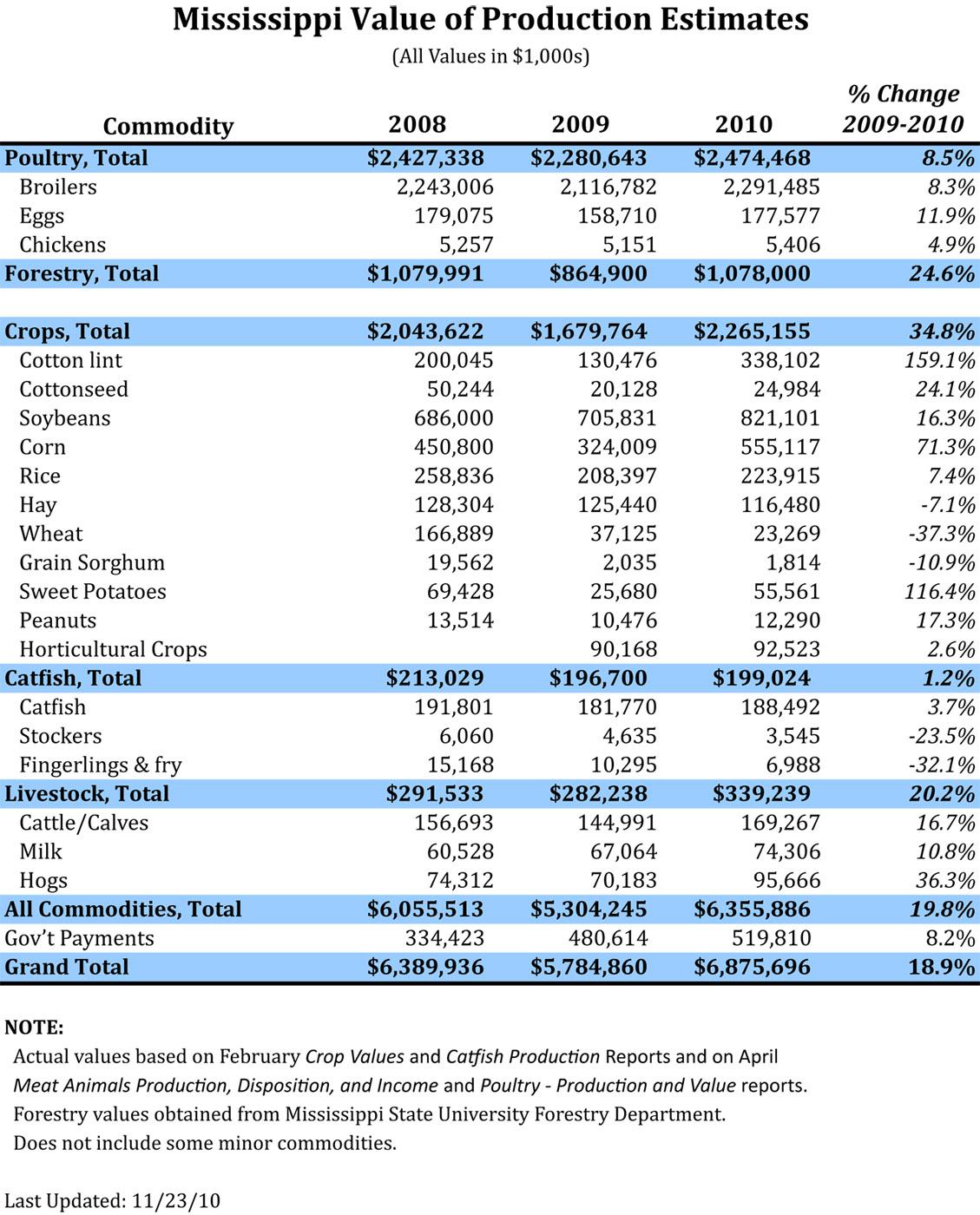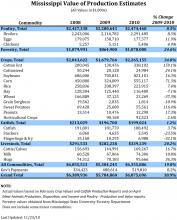Information Possibly Outdated
The information presented on this page was originally released on December 16, 2010. It may not be outdated, but please search our site for more current information. If you plan to quote or reference this information in a publication, please check with the Extension specialist or author before proceeding.
Mississippi ag commodities post record values in 2010
MISSISSIPPI STATE -- Mississippi farmers are finding out not only what a difference a year makes, but also what a difference a decade makes.
Agricultural economists with Mississippi State University’s Extension Service predict a record $6.9 billion production value for the state’s farm enterprises. The figure represents a 19 percent increase, or $1.09 billion, from 2009’s disastrous bottom line. After adjusting for inflation of agricultural prices, it is 45 percent, or $1.55 billion, better than in the year 2000. The previous record of $6.4 billion was set in 2005.
Extension agricultural economist John Michael Riley said the state’s top two crops continue to be poultry at $2.5 billion (up 8 percent) and forestry at $1.08 billion (up 25 percent). Soybeans moved into the No. 3 position in 2007 and remain there at $821 million (up 16 percent). In 2000, cotton was Mississippi’s No. 3 crop at a value of $481 million, and soybeans were in sixth place at $164 million.
“The rise of soybeans is due largely to the work of producers and university experts,” Riley said. “The industry has benefitted from the research and Extension efforts that have improved state yields from a typical 25-30 bushels per acre in the late 1990s and early 2000s to the current average of about 40 bushels per acre.”
Mississippi cotton has shifted from an average of 1.15 million acres from 1998 through 2000 to an average of 363,000 acres from 2008 through 2010, resulting in a much lower value of production in recent years.
Jimmy Avery, Extension aquaculture professor at MSU’s Delta Research and Extension Center, said catfish is expected to post its first increase in value in four years, mostly due to improved prices in the last quarter of 2010. Economists are estimating a catfish value of $199 million, up 1 percent from the previous year.
“Catfish have mostly trended down since 2000. The increases in competition from foreign imports have forced farmers to take about 41 percent of their pond acreage out of production,” Avery said. “In 2000, about 6 percent of the frozen catfish fillets were imported. In 2009, that number was closer to 54 percent.”
Riley said all market values for Mississippi crops would have been even better if recent harvests had occurred at the market’s peak.
“Commodity prices for nearly all production agriculture have been on the rise in recent years, but producers have not been able to take advantage of the higher prices,” he said. “For example, prices for row-crop commodities surged in the summer of 2008, but by the time harvest rolled around, prices had dropped significantly below the typical harvest-time declines.”
Riley said 2010 prices gained strength throughout most of the year and positioned Mississippi agriculture for a noteworthy year. Unlike 2009, the weather was more cooperative.
Crops expected to make the biggest percentage improvements from 2009 were cotton, up 141 percent to $363 million, and sweet potatoes, up 116 percent to $56 million. Both were casualties in 2009 due to excessive rains at harvest. Specialists estimated a 75 percent loss of the sweet potato crop in 2009.
Darrin Dodds, Extension cotton specialist, said the August 2009 crop was “unbelievably good” before rains destroyed it. Growers averaged 687 pounds per acre, the lowest in nine years. Although the 2010 crop did not look as good in early August, Dodds said he expects final yield averages to be just below the state record of 1,024 pounds, set in 2004.
“Mississippi cotton had the best start to the season that we have seen in long time; it warmed early, had plenty of soil moisture and very few replants,” he said. “Growers struggled through the hot and dry June, July and August. The crop faced resistant weeds, plant bugs, spidermites and worms. Square shed in the upper portion of the plant was very common during the first week of August due to the excessive heat. However, yields turned out higher than expected.”
Corn is expected to post a 71 percent value increase to $555 million.
Erick Larson, Extension grain crops specialist, said the market deserves most of the credit, but corn productivity was remarkable, considering the drought in Mississippi during the growing season. Record prices per bushel averaged between $5.50 and $5.75, compared to $3.72 in 2009.
“2010 was one of the hottest, driest growing seasons in more than a decade, but our yields are higher than in 2009 and higher than the five-year average,” he said. “The driest area of the state this year was the Delta, where most of the corn is irrigated, so overall yield losses were relatively slight.”
Larson said the dry conditions in early summer contributed to better root development and helped the plants later in the season, if the crop was fortunate enough to receive any rainfall during June and July. This season’s dry conditions did promote quick, efficient crop harvest.
Mississippi’s No. 2 crop, forestry, posted a significant rebound in 2010 from the previous year. The $1.1 billion value was more than $200 million above the depressed 2009 level, which was the only year since 1993 that forestry did not exceed a billion dollars.
Other crop values and their percentage change from 2009 include rice, $224 million, up 7 percent; cattle, $169 million, up 17 percent; hay, $116 million, down 7 percent; hogs, $96 million, up 36 percent; horticultural crops, $93 million, up 3 percent; milk, $74 million, up 11 percent; wheat, $23 million, down 37 percent; peanuts, $12 million, up 17 percent; and grain sorghum, $2 million, down 11 percent.




